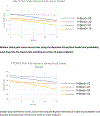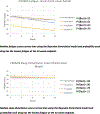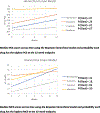A secondary analysis of PAIN-CONTRoLS: Pain's impact on sleep, fatigue, and activities of daily living
- PMID: 35585718
- PMCID: PMC10629716
- DOI: 10.1002/mus.27637
A secondary analysis of PAIN-CONTRoLS: Pain's impact on sleep, fatigue, and activities of daily living
Abstract
Introduction/aims: Peripheral neuropathies commonly affect quality of life of patients due to pain, sleep disturbances, and fatigue, although trials have not adequately explored these domains of care. The aim of this study was to assess the impact of nortriptyline, duloxetine, pregabalin, and mexiletine on pain, sleep, and fatigue in patients diagnosed with cryptogenic sensory polyneuropathy (CSPN).
Methods: We implemented a Bayesian adaptive design to perform a 12-wk multisite, randomized, prospective, open-label comparative effectiveness study in 402 CSPN patients. Participants received either nortriptyline (n = 134), duloxetine (n = 126), pregabalin (n = 73), or mexiletine (n = 69). At prespecified analysis timepoints, secondary outcomes, Patient Reported Outcomes Measurement Information System (PROMIS) surveys including Short Form (SF)-12, pain interference, fatigue, and sleep disturbance, were collected.
Results: Mexiletine had the highest quit rate (58%) due to gastrointestinal side effects, while nortriptyline (38%) and duloxetine (38%) had the lowest quit rates. If tolerated for the full 12 wk of the study, mexiletine had the highest probability (>90%) of positive outcomes for improvements in pain interference and fatigue. There was no significant difference among the medications for sleep disturbance or SF-12 scores. Adverse events and lack of efficacy were the two most common reasons for cessation of therapy.
Discussion: Physicians caring for patients with CSPN should consider mexiletine to address pain and fatigue, although nortriptyline and duloxetine are better medications to trial first since they are better tolerated. Future research should compare other commonly used medications for CSPN to determine evidence-based treatment strategies.
Keywords: fatigue; pain; randomized control trial; sensory neuropathy; sleep.
© 2022 Wiley Periodicals LLC.
Conflict of interest statement
Disclosure of Conflicts of Interest
None of the authors has any conflict of interest to disclose.
Figures




Comment in
-
Pain, sleep, fatigue, and activities of daily living in patients with neuropathy.Muscle Nerve. 2022 Oct;66(4):380-381. doi: 10.1002/mus.27692. Epub 2022 Aug 12. Muscle Nerve. 2022. PMID: 35919957 No abstract available.
References
-
- Barohn RJ. Approach to peripheral neuropathy and neuronopathy. Semin in Neurology. 1998;18:7 18. - PubMed
-
- Wolfe GI, Barohn RJ. Cryptogenic sensory and sensorimotor polyneuropathies. Semin Neurology. 1998;18:105–111. - PubMed
-
- Wolfe GI, Baker NS, Amato AA, Jackson CE, Nations SP, Saperstein DS, Cha CC, Bryan WW, and Barohn RJ. Chronic cryptogenic sensory polyneuropathies: clinical and laboratory characteristics. Arch Neurol. 1999;56:540–547. - PubMed
Publication types
MeSH terms
Substances
Grants and funding
LinkOut - more resources
Full Text Sources
Medical

